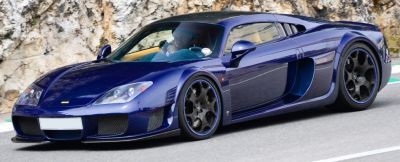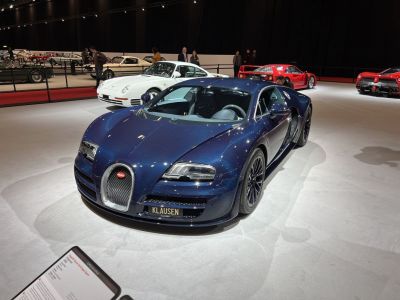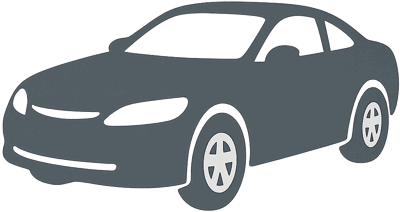 1992 Bugatti EB 110 Dimensions, Size & Specs
1992 Bugatti EB 110 Dimensions, Size & SpecsMeasurements of the 1992 Bugatti EB 110, engineered for optimal performance and comfort
| Dimensions | |
|---|---|
| Length: | 4400 mm173.2 in14.4 ft |
| Width: | 1940-1960 mm76.4-77.2 in6.4-6.4 ft |
| Height: | 1125 mm44.3 in3.7 ft |
| Trunk Capacity: | 72 liter2.5 cu ft |
| Weight Specifications | |
| Curb Weight: | 1418-1620 kg3126-3571 lbs |
| Maximal permitted Weight: | 1720-1870 kg3792-4123 lbs |
| Tire Specifications | |
| Rims Size: |
|
| Tire Sizes: |
|
The Bugatti EB 110, produced from 1991 to 1996, is a legendary supercar that combines Italian engineering brilliance with French automotive heritage. The 1992 EB 110 coupe is a striking example of early 1990s automotive innovation, offering an aggressive yet aerodynamic profile with precise dimensions suited for a high-performance sports vehicle. Measuring 4400 mm (173.2 inches) in length, the EB 110 strikes a balance between agility and road presence, while its width ranges from 1940 mm to 1960 mm (76.4 to 77.2 inches), providing stability at high speeds and excellent cornering capabilities. Standing just 1125 mm (44.3 inches) tall, the car maintains a low, streamlined silhouette to minimize air resistance. Weighing between 1418 kg and 1620 kg (3127 to 3571 pounds) in curb weight, the EB 110 delivers a lightweight yet rigid chassis designed for dynamic driving performance. The maximum allowable weight varies from 1720 kg to 1870 kg (3792 to 4123 pounds), accounting for fuel, passengers, and additional loads. Despite its compact supercar size, the EB 110 incorporates a functional luggage compartment with a capacity of 72 liters (2.54 cubic feet), providing limited but practical storage space. The vehicle rides on 18-inch rims, wrapped with front tires sized 245/40 R18 and rear tires sized 325/30 R18, underscoring its focus on traction and handling precision. This combination of dimensions and specifications establishes the Bugatti EB 110 as an iconic supercar of its era, revered for its advanced engineering, unique styling, and impressive performance credentials.
Discover the standout features that make the 1992 Bugatti EB 110 a leader in its class
Have a question? Please check our knowledgebase first.
The Bugatti EB 110 from the generation produced between 1991 and 1996 has a length of 4400 mm (approximately 173.2 inches), a width ranging between 1940 mm to 1960 mm (76.4 to 77.2 inches), and a height of 1125 mm (44.3 inches). These dimensions make the EB 110 a compact yet wide and low-slung sports coupe designed to optimize aerodynamic performance and aesthetics typical of early 90s supercars.
The Bugatti EB 110 has a curb weight ranging from 1418 kg to 1620 kg (3126 to 3571 lbs), depending on the specific variant and any optional equipment fitted. The maximum permissible weight is between 1720 kg and 1870 kg (3792 to 4123 lbs). This relatively lightweight composition, especially for a supercar with advanced technology and performance, contributes to its exceptional handling and speed capabilities.
The Bugatti EB 110 measures between 1940 mm and 1960 mm (approximately 76.4 to 77.2 inches) in width. This broad stance improves stability at high speeds and enhances cornering precision by lowering the center of gravity and improving tire contact with the road. The wide track contributes to the superb grip and control expected from such a high-performance vehicle.
A typical single-car residential garage door width is about 2438 mm (96 inches) and height about 2134 mm (84 inches). With a width of up to 1960 mm (77.2 inches) and height of 1125 mm (44.3 inches), the Bugatti EB 110 fits comfortably in most standard garages. Its length of 4400 mm (173.2 inches) also fits within typical garage depths, which are usually over 5000 mm (197 inches). Thus, owners should have no problem accommodating the EB 110 in most single-car garage spaces.
The Bugatti EB 110 offers a luggage capacity of just 72 liters (about 2.54 cubic feet). While this is quite minimal compared to conventional cars, it is typical for supercars where priority is on performance rather than utility. This limited storage space is adequate for a couple of small bags or personal items, making the EB 110 more suitable for short trips or weekend drives rather than long journeys requiring extensive luggage.
The Bugatti EB 110 rides on 18-inch rims fitted with tires sized 245/40 R18 at the front and 325/30 R18 at the rear. These staggered tire sizes contribute to its exceptional grip and handling, with the wider rear tires providing better traction necessary to manage the powerful all-wheel-drive system and the car’s high output. The large rims also support advanced braking components and help dissipate heat efficiently during spirited driving.
The Bugatti EB 110 does not have a direct predecessor as it was introduced after a long gap since the last notable Bugatti model (Type 57 and other classic models from mid-20th century). It marked a dramatic modernization in design, size, and technology. It is more compact and technologically advanced than older Bugatti supercars, featuring a mid-engine layout, all-wheel drive, and lightweight materials that set new standards for the brand, contrasting with the larger, heavier, and more classic designs of earlier models.
The Bugatti EB 110, with its length of 4400 mm, width of up to 1960 mm, and height of 1125 mm, is comparable in size to contemporaries like the Ferrari F40 and the Jaguar XJ220. However, it distinguishes itself with its advanced carbon-fiber chassis, all-wheel-drive system, and a quad-turbocharged V12 engine. The EB 110 was often considered more technologically advanced and versatile in terms of handling due to its all-wheel drive, while its size made it manageable like its peers, balancing low height with a wide stance for stability.
With a curb weight ranging from 1418 kg to 1620 kg (3126 to 3571 lbs), the EB 110 is relatively lightweight, especially considering its size and the advanced engineering it carries, including a V12 quad-turbocharged engine and all-wheel-drive system. This weight is competitive with similar supercars of its era, many of which also used lightweight materials like carbon fiber and aluminum. The relatively low weight enhances acceleration, agility, and braking performance.
Despite its compact height of 1125 mm (44.3 inches), the Bugatti EB 110 offers an ergonomically designed cockpit typical of early 90s exotic cars, focused on driver engagement and performance. Its wide track provides a stable and comfortable driving experience by reducing body roll. The low height delivers a sporty, low seating position that enhances road feel and aerodynamics but may reduce overall headroom. Comfort is balanced with the car’s performance orientation, emphasizing driver focus over luxury space.
Discover similar sized cars.

| Production: | 2011-2016 |
|---|---|
| Model Year: | 2011 |
| Length: | 4360 mm171.7 in |
| Width: | 1910 mm75.2 in |
| Height: | 1120 mm44.1 in |

| Production: | 2005-2011 |
|---|---|
| Model Year: | 2005 |
| Length: | 4462 mm175.7 in |
| Width: | 1998 mm78.7 in |
| Height: | 1190-1204 mm46.9-47.4 in |

| Production: | 1996-1999 |
|---|---|
| Model Year: | 1996 |
| Length: | 4450 mm175.2 in |
| Width: | 1990 mm78.3 in |
| Height: | 1190 mm46.9 in |
